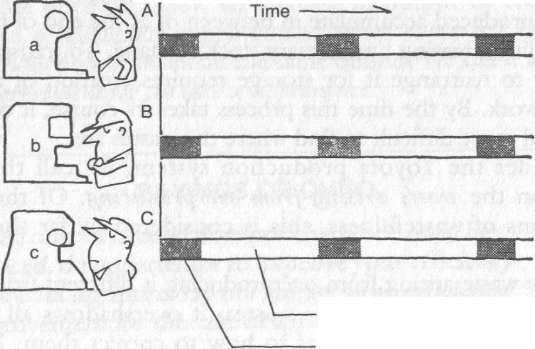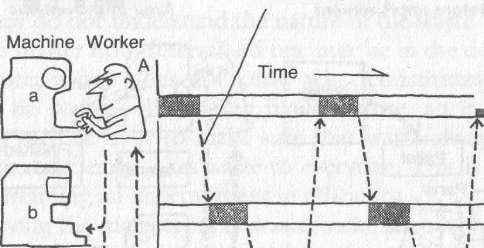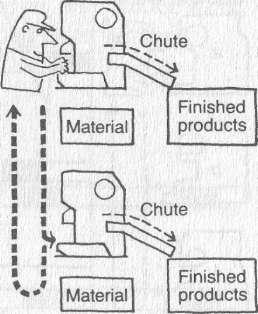
- •14 Continuous Improvement in Operations
- •It's a crime to overproduce
- •Before Improvement Machine Worker
- •Figure 2-3. Waste Arising from Time on Hand
- •Basic Assumptions Behind the Toyota Production System
- •Figure 3-1. The Two Pillars of the Toyota System
- •Figure 3-2. One Goal, Many Approaches
- •I xcess capacity and economic advantage
- •Is it a waste if you do not use an expensive machine?
- •Leveling: Smoothing Out the Production System
- •Figure 4-2. Processing a Gear
- •An Assembly Line Based on the Load-Smoothing Production System
- •Figure 4-4. Load-Smoothing Auto Production
- •It Can't Be Done
Automatic
feed Manual operation
Before Improvement Machine Worker

Figure 2-3. Waste Arising from Time on Hand
In order to eliminate this waste, the worker named A is assigned to all three of these machines to operate their automatic feeds sequentially. Under this arrangement, worker A places material in machine a and pushes the starter figure, switch and moves to machine b. He places material in machine b and starts it. He moves on to machine c, and repeats the same process he has done with machines a and b. After с is started, he moves back to a. By the time worker A returns to machine a, the work there is completed, and he can immediately start another round of work on machine a.
By eliminating the waste arising from waiting, two workers can be removed from the work process. Similarly, one may also consider eliminating unnecessary motions, which do not contribute to the work itself.
The waste arising from transporting refers to waste caused by an item being moved a distance unnecessarily, being stored
Figure 2-4. Eliminating Waste Arising from Time on Hand
temporarily or being rearranged. For example, traditionally parts are transferred from a large storage pallet to a smaller one and then placed temporarily on a machine several times before they are finally processed. By improving the pallets, we have been able to dispense with these temporary placement procedures and let one worker operate two machines.
Another instance of waste arising from transporting occurs when parts are moved from a warehouse to the factory, from the factory to the machines and from the machines to the hands of workers. At each of these steps, parts have to be rearranged and moved.
The waste arising from processing itself occurs, for example, when a guide pin in the jig does not function properly and the worker has to hold the jig with his left hand. The processing does not go smoothly and time is wasted.
In addition, there are wastes arising from unnecessary stock on I land, from unnecessary motion and from producing defectives. Explanations for each of these are not necessary.
ruminate waste thoroughly
After
Improvement < Walking
1Ц

![]()
![]()
![]()
Before
Improvement
Pallet
(material)
Pallet
(finished products)
After
Improvement

![]()
Pallet
Parts
О
.Что
Figure 2-5. Eliminating Waste Arising from Transporting
SAYINGS OF OHNO
A worker or a line with excess capacities inevitably moves forward if left alone. When this happens, wastes are hidden.
In other words, overproduction creates a countless number of wastes, such as over-staffing, pre-emptive use of materials and energy costs, advance payment to workers, interest charges on mechanical devices and products, storage areas needed to accommodate the excess products and the cost oftransporting them. In a period of low economic: growth, overproduction is a crime.
of them consider such an act a necessary part of their job, and often they do not understand the nature of the waste.
No matter how determined one may be in the desire to eliminate waste, if one does not know what constitutes waste, then there is no way of eliminating it. Therefore, an important task awaiting each of us is to make sure that waste always appears — distinctly and clearly— as waste to everyone. This is the first step toward attaining an improvement in efficiency.
Among the many types of waste, some are easy to discern and others are difficult. Among them, the easiest to discern is the waste arising from time on hand, or waiting.
For example, if the cycle time is three minutes and there is a one-minute period of waiting before a worker can resume his work, the worker himself, his supervisor and other supervisors certainly will know that this one minute is wasted. However, if the worker moves around to spend this one minute as if he were working, no clear-cut image will emerge (the wastes of transporting and of processing itself). Or if he should use this time to process the next item, no one can tell if a waste has actually occurred (the waste of overproducing). All these three wastes must be translated back into the waste arising from waiting. It can facilitate devising appropriate countermeasures.
In this connection, we may consider taking the following three steps:
-
Let the workers strictly observe the standard operations. Do not allow any deviation.
-
Control excessive forward movements through the production system, which utilizes kanban?
-
Clearly indicate on the conveyor line the work area for each worker, thus preventing any worker from moving ahead of the schedule to do excessive work.
An important thing to remember is that to eliminate waste, you must find it first. You must rearrange the workplace in such a
Л kanban is a signboard or card; the work also refers to the system utilizing st andard containers, each of which has a card designating what and when to producc.
way that waste can be easily found. Each of the steps you take by themselves seem insignificant. For example, you may even have to worry about a small quantity of goods stored between two processes. But as long as the problem is related to your "efficiency enhancement — cost reduction" movement, you must be prepared to ask this question: "Why has this occurred?" Before long, you may find a clue to the very improvement you are seeking.
Enhancement of efficiency can be attained through elimination of waste. Of course, there are may way of finding different wastes. But the most effective way remains that of translating such wastes into the waste arising from waiting. It is one that is easy to detect, and provides the first step toward efficiency enhancement.
This total dedication to the elimination of waste is the heart and soul of the Toyota production system. It also constitutes the very source of its profit.
